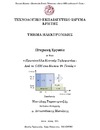| heal.creatorName | Ταμπουρατζής, Μανόλης | el |
| heal.creatorName | Tampouratzis, Manolis | en |
| heal.publicationDate | 2011-05-06T15:31:48Z | |
| heal.identifier.primary | http://hdl.handle.net/20.500.12688/2029 | |
| heal.abstract | Σκοπός της παρούσας εργασίας είναι η ανάλυση των βασικότερων πρωτοκόλλων κάθε «γενιάς» στην κινητή τηλεφωνία. Πιο αναλυτικά, στο πρώτο κεφάλαιο αναφέρονται ιστορικά στοιχεία και επιγραμματικά τα αρχικά πρωτόκολλα που χρησιμοποιήθηκαν. Το δεύτερο κεφάλαιο είναι αφιερωμένο κυρίως στο πανευρωπαϊκό πρότυπο κινητών επικοινωνιών GSM, το πιο γνωστό ψηφιακό σύστημα κινητών επικοινωνιών στον κόσμο. Στις ενότητές του προηγείται μία σύντομη εισαγωγή στη δομή των δικτύων κινητής τηλεφωνίας δεύτερης γενιάς και στη συνέχεια περιγράφεται λεπτομερώς η αρχιτεκτονική του GSM. Έπειτα αναλύεται η διεπαφή αέρα Um. Συγκεκριμένα αναφέρονται τα λειτουργικά χαρακτηριστικά και το διαθέσιμο ραδιοφάσμα στο GSM, αναλύεται η δομή της στοιχειώδους μορφής της ψηφιακής πληροφορίας (ριπή), εξετάζονται τα φυσικά και λογικά κανάλια που αποτελούν τους φορείς των διαφόρων τύπων μηνυμάτων, ενώ τέλος το κεφάλαιο κλείνει με αναφορά στους εθνικούς και διεθνής αριθμούς πιστοποίησης. Το τρίτο κεφάλαιο περιγράφει τις τεχνολογίες πρωτοκόλλων 2.5G γενιάς χαρακτηριζόμενη και ως μεταβατικής, με βασική αναφορά στο GPS σύστημα καθώς και στη μετεξέλιξη του, το EDGE. Στο κεφάλαιο 4 γίνεται περιγραφή των τηλεπικοινωνιακών συστημάτων 3ης γενιάς με κυρίαρχο το πρωτόκολλο UMTS, καθώς και της παρεχόμενης Ποιότητας Υπηρεσίας (Quality of Service – QoS) σε 3G δίκτυα. Τέλος, στο κεφάλαιο 5 αναλύεται το πρωτόκολλο WiMaX ως μία νέα ανταγωνιζόμενη Ασύρματη Τεχνολογία, καθώς επίσης και η διασύνδεσή της με τα υπάρχοντα δίκτυα κινητών επικοινωνιών. | el |
| heal.abstract | The purpose of this study is the analysis of main protocols each "generation" in cellular telephony. More specifically the first chapter presents historical data and original protocols were used. The second chapter is devoted mainly to the pan‐European mobile communications standard GSM, the most famous digital mobile communications system in the world. In those modules, preceded by a brief introduction to the structure of mobile networks to second generation and then details the architecture of GSM. Then analyzes the air interface Um. Specifically, indicate the operating characteristics and the available spectrum for GSM, analyzed the structure of the basic form of digital information (burst), examines the physical and logical channels which are the carriers of the different message types and finally the chapter ends with a reference to national and international certification numbers. The third chapter describes the 2.5G Generation protocol technologies characterized as "transitional" in reference to the GPRS core system and the evolution of the EDGE. Chapter 4 contains a description of third "generation" telecommunication systems dominated by the UMTS protocol and the provided QoS (Quality of Service ‐ QoS) in 3G networks. Finally, in Chapter 5 explores the protocol WiMaX as new competing wireless technology as well as linking with existing mobile networks. | en |
| heal.language | el | |
| heal.academicPublisher | Τ.Ε.Ι. Κρήτης, Σχολή Εφαρμοσμένων Επιστημών (Σ.Εφ.Ε), Τμήμα Ηλεκτρονικών Μηχανικών Τ.Ε. | el |
| heal.academicPublisher | T.E.I. of Crete, School of Applied Sciences, Department of Electronic Engineering | en |
| heal.title | Πρωτόκολλα κινητής τηλεφωνίας: από το GSM στα δίκτυα 4ης γενιάς. | el |
| heal.title | Mobile telephony protocols: from GSM to 4 generation networks. | en |
| heal.type | bachelorThesis | |
| heal.keyword | κινητή τηλεφωνία, ραδιοδίαυλος, διαμεταγωγή, δίκτυο κινητής τηλεφωνίας, πρωτόκολλα δικτύων υπολογιστών, Παγκόσµιο Σύστηµα Κινητών Επικοινωνιών, παγκόσμιο σύστημα κινητών τηλεπικοινωνιών (UMTS), high speed downlink packet access 3G (HSDPA), δίκτυο τέταρτης γενιάς, WiMAX | el |
| heal.keyword | mobile telephony, radio channel, switching, mobile telephony network, computer network protocols, Global system for mobile communications, universal mobile telecommunications system (UMTS), high speed downlink packet access 3G (HSDPA), 4G network, WiMAX | en |
| heal.advisorName | Αντωνιδάκης, Εμμανουήλ | el |
| heal.advisorName | Antonidakis, Emmanouil | en |
| heal.academicPublisherID | teicrete | |
| heal.fullTextAvailability | true | |
| tcd.distinguished | false | |
| tcd.survey | false | |


